Porcelain Insulator News
by Elton Gish
Reprinted from "Crown Jewels of the Wire", January 2002, page 9
There are so many new reports about porcelain insulators that we cannot hope
to cover all of them in PIN. Usually it is hard figure out what to discuss next,
but this month we have some rather dramatic news to cover. I don't recall ever
having a previously unreported super classic lily-shell multi, two new Fred
Locke uniparts, and a new Fred Locke marking to report all at the same time.
This is exactly the exciting news to cover this month!!
When I published the
book, Fred M. Locke: A Biography, I did not think there would be any significant
new finds for many years. Nothing could have been farther from the truth. Some
may argue that Ebay has been bad for insulator prices, but few can dispute the
benefit of drawing some unique porcelain insulators out of hiding. Recently, a
totally new style of Fred Locke insulator was offered on Ebay. It fits in the
U-923 cross-top series and challenges the alphabet for that series. The series
now has two new additions. The first one is U-923F with not one but two
under-glaze ink markings - and one of the markings is a new one! !
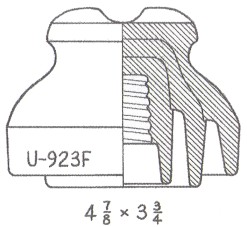
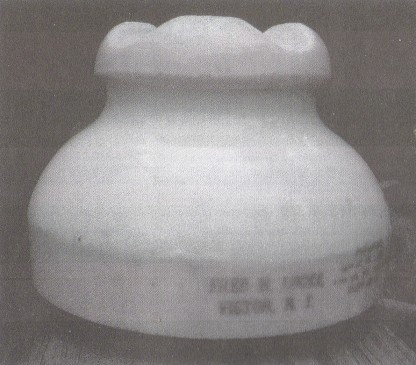
U-923F Fred Locke cross-top with
two under-glaze ink markings.
Before Fred Locke opened his porcelain insulator factory in the summer of
1898 in Victor, NY, he was having U-923B and U-923C cross-top insulators made for
him of dry process porcelain by the R. Thomas & Sons Co. (East Liverpool,
OH). These have Fred Locke patent dates "embossed" in the cross-top
grooves except for a few specimens of U-923C. They were made from early 1895
until late 1896 when Fred asked Imperial Porcelain Works (Trenton, NJ) to make
the same style from higher quality wet process porcelain. Imperial made the
basic U-923 style (U-923 and U-923A) from one piece of porcelain. Their small
factory soon pushed production of insulators beyond its capacity, which resulted
in visible cracks and flaws in the insulators. Some of Fred Locke's customers
rejected up to 50% of orders due to these obvious flaws. He refused to pay
Imperial for the rejected insulators and the shipping expense to the western
states, and Imperial filed suit against him to recover payments. The loss of a
reliable supplier in early 1897 forced him to find another insulator
manufacturer.
Fred Locke went to Electrical Porcelain & Mfg. Co., which was also
located in Trenton, NJ. That company was started in April 1895 making
house-wiring insulators from dry process porcelain. In 1897, Fred Locke worked
with EPMC to develop wet process porcelain pin-types probably based on his
observations of the process at Imperial. However, firing thick wet process
porcelain had been mastered only by Imperial. EPMC and Fred Locke decided to use
the easier method of making insulators comprised of two or three porcelain
shells glazed separately, fitted together, and fired to fuse the shells into
essentially one insulator. This process was known as glazewelding. Thomas sued
Fred Locke and EPMC for patent infringement on their 1898 Boch patent for "glazefilling",
which used extra glaze to fill the gaps between the shells. After an extended
court fight and appeals, Fred Locke and EPMC lost in late 1901, and the parties
were ordered to pay damages. EPMC apparently went bankrupt because of it. This
whole story and much more can be found in my book.
U-923F was made by EPMC for
Fred Locke based on the style he had made at Thomas and Imperial. It is a
cross-top style in the U-923 series and is the only style in that series made by
EPMC. It was made of three shells glazewelded together (outer shell and one
shell for each of the two inner skirts). What makes this insulator even more
unique are the two blue under-glaze ink markings on the flat side of the skirt.
The first marking is #0-5:
FRED M. LOCKE,
VICTOR, N.Y.
This marking is only known on three specimens of U-4 (two with tan glaze and
one with a white glaze). The second marking is new and has been assigned #5-2:
PATENTED
MAY 22, 94, - MAY 89,
NOV. 24, 96, - DEC. 15, 96,
SEPT. 28, 97.
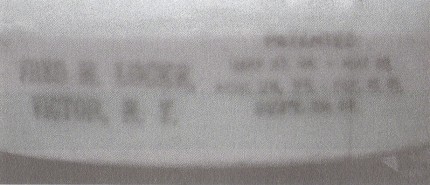
Two rare under-glaze ink markings on U-923F.
The marking is similar to marking #5-1, which appears only on specimens of
U-927A and U-939. Marking #5-1 probably came after #5-2 since it has Fred
Locke's name incorporated in the marking, the 1889 patent date is in the correct
order (before the 1894 date), and "Other Patents Pending" indicates
applications for additional patents were filed. This latter notation on #5-1
probably indicates that marking was used after the April 23, 1898 filing date of
Fred Locke's next patent. The cross-top U-923F would naturally be the first
insulator style Fred Locke would ask EPMC to make, which makes it a missing link
in the chain of events. Since Fred always insisted on marking all his insulators
with his name, EPMC had to use both marking stamps until the patent marking
could be revised to #5-1. Note, too, that the May 89 patent date in #5-2 marking
was out of order and later corrected in the new marking, #5-1. The U-923F was
probably made in early 1897 and was most likely the first insulator EPMC made
for Fred Locke.
This lone specimen of U-923F was found recently at a sale in
Middleville, NY and offered on Ebay. Note the huge partially open air bubble in
the cable groove, which makes it even more special for the classic porcelain
collector!! You never know when a new Fred Locke style will appear. There are
surely more of this type out there somewhere and other unreported styles may
some day show up that match odd styles that have been found in the Victor
factory dump.
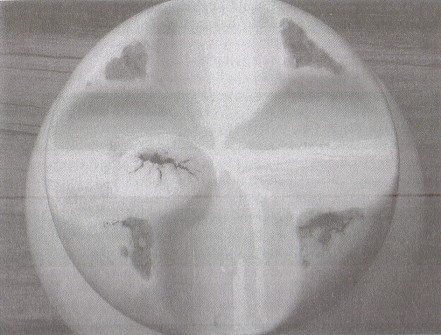
Note the large partially open bubble
in the cable groove of U-923F.
Rick Soller reported the next insulator, which I assigned U-923G. He said it
was found in Canada and brought it to the 31st Mid-Ohio Insulator Show last
November. It certainly is an odd style and many people offered speculation about
its origin. Since it was made of dry process porcelain, some people thought G.E.
could have made it during the mid-1890's when they produced U-701 and U-744. The
show was quite busy and I did not have much time to consider possible
manufacturers. I quickly made a shadow profile drawing, recorded all the various measurements, and took a few photographs of it. When I got home and
started to make the drawing needed to assign a new U-number, it suddenly hit me
that this was indeed a Fred Locke design! It really could not be anything else.
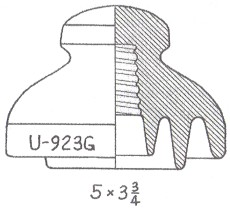
Fred Locke's first porcelain insulator: U-923G
I know U-923G is a Fred Locke design because he was the one to develop the
extended middle petticoat and the apparent age puts the insulator at this early
time. When Fred started the partnership, Fred M. Locke & Co., in late 1893,
he asked Hemingray to make his triple petticoat style, CD 287.1. Later he had
the same basic style, CD 287.2, made by Brookfield. The first production was the
small crown style with petticoats that got progressively longer from center to
outside. In early 1894, he developed the idea of extending the middle petticoat
to prevent arcing from the outer skirt to the pin. This feature was put into the
large crown version of CD 287.2, which makes it significantly different than the
small crown CD 287.2.
It was not until after the partnership broke up on May
13,1895 that Fred decided to produce a porcelain insulator. At this time he went
to R. Thomas & Sons in East Liverpool, OH and placed orders for the first
triple petticoat porcelain insulator, which they made of dry process porcelain -
similar to the door knobs they were making. It was his first venture into making
an insulator for electric power transmission and I'm sure Fred was still
thinking of tying the wire on the side of the insulator like was customary for
telegraph work. Yes, this was most likely U-923G! At this early stage of
insulator production, Thomas probably had a difficult time threading a pinhole.
In fact, the specimen of U-923G has a pinhole that appears to have been made
separately from the insulator. I don't know how they could have inserted
pre-formed threads, but it certainly appears that is the case. There is no way
to prove this short of cutting the insulator in half, or maybe finding a doctor
who would consent to x-raying it.
The cross-top design of the U-923 series came
later when he realized the heavier conductor of a power line would be supported
more securely if it was allowed to rest in a groove on top of the insulator.
However, to have a better chance of screwing the insulator down tightly on the
pin and still have the cable groove aligned in the correct manner, he came up
with the novel idea of using crosstop grooves. A simple quarter turn in any
direction after the insulator was fully screwed down would provide a groove
aligned correctly to lay the conductor in. The awkward conductor attachment for
U-923G (and potentially weak crown) probably brought a quick end to that style. Fred then asked Thomas to make U-923B and
U-923C and had
his name and patent dates prominently "embossed" in the cross-top
grooves. A few U-923C's are unmarked, which may indicate that they were the
first cross-tops made. The design was so popular that he had it made by Imperial
of superior wet process porcelain, later U-923F by EPMC, and U-923D, which he
made at his own factory in Victor, NY. If you have doubts that U-923G fits in
the U-923 cross-top series, note the same extended middle petticoat and the
characteristic square side of the skirt. U-923C is the only one that does not
have a prominent square side, but some I have seen do have a slight square band
around the skirt. It may have something to do with the transition of changing
the crown design, which temporarily displaced the square side feature.
So, we
have two missing links found a month apart and reported in the same PIN
article!! What more can you desire? In case you are wondering about where U-923E
fits in all this, it was made by Imperial in 1903 for their own sale. Specimens
are finely made and bear only a manufacturing date.
The next insulator has been
sought after by multipart collectors longer than M-3250. About a dozen M-3250's
have been captured over the past few years leaving M-3890 as the most desirable
unreported style. We still have not found a whole M-3890, but we now have the
next best thing - a very similar but new style, M-3890A. I assigned a new
M-number to it because the crown was so different from the M-3890 crowns found
in New York making the insulator a full 1-inch taller. The huge insulator is
20-inches tall with a top skirt diameter of 14-1/2". A few shells of
M-3890's made by Thomas and New Lexington have been found near the historic
Lockport line near Buffalo, NY, but there have not been enough pieces or shells
to put together a whole specimen.
If you have my new book, Multipart Porcelain
Insulators - 2nd Edition, look at the Thomas advertisement on page 332 ("The
Electrical World", June 1, 1907). This is what Ron Yuhas used to describe
the insulator when he reported it. Note in the photograph shown here that the
crown is much taller. Ron said he bought the insulator from a guy in Montana who
had it in his yard. The guy said he got it about 15 years ago but didn't
remember where. The glaze color is the typical early Thomas mottled
orange-mustard. It still has a large wooden pin stuck in the pinhole. It
probably survived all these years inside an old powerhouse, as was the case for
all the known M-3250's. The M-3250's found in the west also have a similar large
wooden pin stuck in the pinhole.
 |
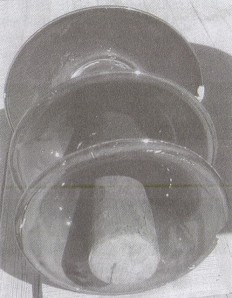 |
Thomas M-3890A
(14.5 -12.75 -11.5 x 20) |
Bottom view of M-3890A.
Note the large wooden pin. |
The Swan Falls hydroelectric plant near Boise, ID has been converted into a
museum. About 12 M-3250's and 30 M-3890's are mounted to the ceiling and support
copper buswork. It is an exciting sight!! You can learn more about this amazing
discovery and see some nice photos of it in the latest issue of Ed Sewall's
magazine, "Power Line Explorer Journal", Fall 2001. It definitely is
well worth the modest $6 per year subscription price for two issues
(subscription info at www.r-infinity.com). Mike Spadafora and Alan Drew wrote
the article. The article has a lot of good historical information and
photographs that you should not miss along with several other very interesting
articles.
I've got to report the next find now as it is just too exciting to
keep. Ken Stefan brought a few things for me to see at the Mid-Ohio show in
Springfield last November (formerly the London show). He did some digging at the
old Thomas factory site and pulled out a crown of a M-3990 (20-inch diameter!!). The crown on M-3750 and M-3990 was something most of us could not believe
and I had doubts that the catalog illustration was accurate. Now we know for
sure the catalog did indeed show the crown accurately. This strange crown was
formed by simply trimming in the tie-wire groove and cutting out the cable groove. Not a very strong crown for such a large insulator. The
top firing rest has an incuse marking that looks like "JAN 12" filled
in with glaze. The glaze color is the early Thomas mottled orange-mustard just
like on M-3890A. We will never have so much rarity to report on one PIN again.
Enjoy!!
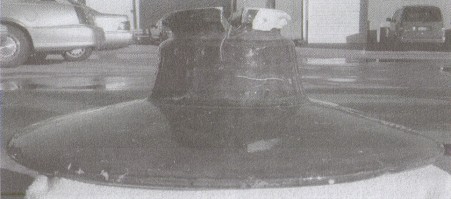
Damaged top shell of either a M-3990
found at the Thomas factory site.
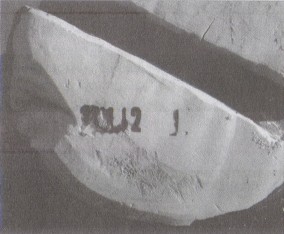
Note incuse marking on top:
JAN 12
| 